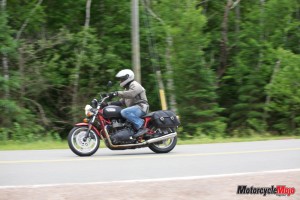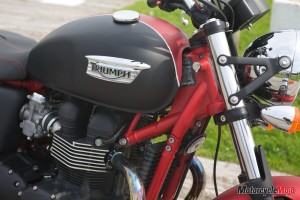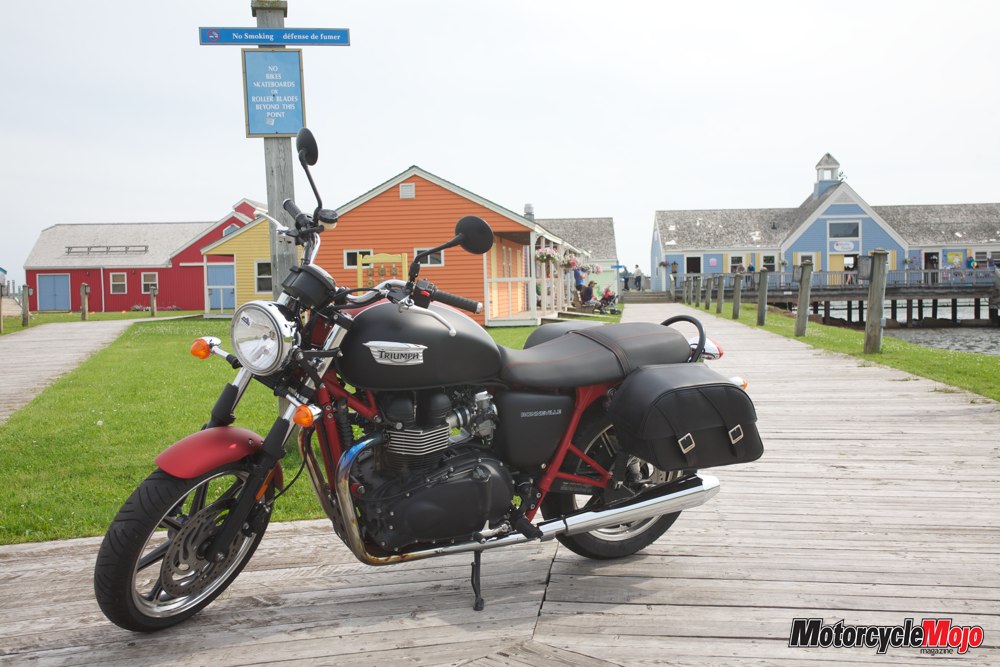It’s no surprise that vintage-styled motorcycles hold a special place in the hearts of many motorcyclists. And for good reason. Their timelessness reminds us of an era that exuded soul and tradition.
The first Bonneville rolled off the line over 55 years ago, and this neat, compact, newer version exudes that timeless beauty and classic styling. It sits at the forefront of Triumph’s Classic line of motorcycles, along with the Scrambler and the Thruxton – all with a rich history and worthy to be in the category.
We decided that if bikers of decades past could ride standard machines like this across the country, certainly we could tackle a quarter of the country on a modern variation of the classically styled Bonnie. We were destined for Prince Edward Island, and Mojo staffer Martin van der Staay ponied up to ride the new Bonneville Special Edition. As for comfort, I wasn’t sure what to expect, but Martin is young and pliable, a hard-core rider, so I figured he could take it.
We left Southern Ontario later in the day than expected, turning a two-day trip into three. What we didn’t plan on was three days of rain – and at times, chilly temperatures – to get to our destination of Summerside, P.E.I., for the 2013 running of the Atlanticade motorcycle rally. The Bonnie was to have a windscreen installed, but one couldn’t be sourced in time for our trip. Of course, many riders back in the day wouldn’t have had a windscreen. However, we are riding in 2013, and being used to some added conveniences on today’s bikes, we ended up stopping earlier than planned at Rivière-du-Loup, Quebec, because Martin’s rain gear didn’t work as expected and the temperature had dropped to seven degrees in the foggy evening. I must say that I was chuckling while riding the K1600GTL, BMW’s full-on touring rig, as I adjusted my power windshield and changed the heat settings of the grips and the seat.
 As luck would have it, during the weekend at Atlanticade the clouds dispersed, leaving warm sunshine when it was my turn to ride the Bonnie.
As luck would have it, during the weekend at Atlanticade the clouds dispersed, leaving warm sunshine when it was my turn to ride the Bonnie.
While today’s Bonneville is designed to look traditional, it is a fully modern machine. It drew a lot of attention, as many rally goers would stop in their tracks to walk around it. Part of the draw was the Special Edition’s stunning paint scheme of matte black and matte red with tasteful white pinstripes. Finishing the obvious styling exercise is the red stitching in the seat. With only 23 in the country, the Special Edition is made up of cosmetic differences only; it and the standard Bonneville are identical mechanically.
 Many would ask its year, and once we realized the trend of the questions, we countered with, “What year do you think it is?” Some guessed at new, but most said somewhere in the ’70s and were a little shocked when we said it was a 2013 model that had only six kilometres on it four days ago. Three rain-soaked days and 1700 km worth of road grime, along with the ingenious hidden fuel injectors inside the faux carbs, and old-style tank badges helped to feed the illusion that the bike was from a previous era.
Many would ask its year, and once we realized the trend of the questions, we countered with, “What year do you think it is?” Some guessed at new, but most said somewhere in the ’70s and were a little shocked when we said it was a 2013 model that had only six kilometres on it four days ago. Three rain-soaked days and 1700 km worth of road grime, along with the ingenious hidden fuel injectors inside the faux carbs, and old-style tank badges helped to feed the illusion that the bike was from a previous era.
Make no mistake, only the look is vintage. The 865 cc, fuel-injected engine uses a 360-degree firing interval. Vibration is inherent to the 360-degree engine since both pistons rise and fall at the same time, but the addition of balance shafts keep it to a minimum, felt only in the foot pegs at high engine speeds, and in no way bothersome. The fitment of optional mufflers let the engine’s sound ring out in a crisp, but pleasing tone.
The air-cooled engine’s top gear roll-on won’t rip your arms out of their sockets, but that isn’t what this bike is about. You might want to downshift one or two gears if a hurried pass is required, but the engine is calming and unintimidating. It is ideal for sauntering along country roads at a sedate pace, but it doesn’t balk at keeping up with the fastest traffic on our major high-speed highways. During our trip east on the Trans-Canada we pushed the pace, and it never flinched at the speed required to keep up with the quickest traffic. On hot days and at high speeds, the oil cooler helps to keep engine internals at a proper temperature.
Shifting was always quiet and smooth, and the cable-operated clutch was an easy pull with the adjustable clutch lever.
With only a single, two-piston caliper squeezing the rotor up front, a firm grip is needed on the adjustable brake lever. But don’t let that worry you; a combination of front and rear brake application stops the bike more than adequately.
The seating position is traditional sit-up straight, with a relatively flat seat that allows room to move around. Your hands fall naturally in place on the hand grips, and the foot pegs are comfortably below your hips, keeping your lower back straight.
You come to realize its small stature as you lift the bike off the side stand. The low 740 mm (29.1 in.) seat height is user friendly and unintimidating. The seat is firm and comfortable, at least for reasonable ride times. I didn’t have the opportunity to spend hours at a time on the saddle, but there is plenty of room to move around if it begins to feel uncomfortable.
View from the saddle is basic, with standard switchgear including a passing-light toggle operated by the left forefinger. The single, large analog speedo has an LCD screen at the bottom to display distance travelled, a pair of trip meters and a clock. To the right side of the speedo are the necessary operational lights.
For those times when you are keeping a gentlemanly pace along country lanes and you see a shade tree to rest under or a picture postcard photo op and you need to turn around, the Bonnie is easy to manoeuvre during feet-up, slow-speed U-turns.
The Bonnie will live quite comfortably on the highway at whatever speed you care to maintain, but its user-friendly, laid-back attitude screams for scenic country jaunts and picnics by the shore. It offers a relaxed ride with a low centre of gravity, adjustable clutch and brake levers for various hand sizes, low seat height and unintimidating power – what’s not to like? Whether you are an experienced rider and want to slow life down a bit, or you are new to motorcycling, this bike should appeal to a wide array of riders.
| the basics | |
| List Price | $9,700 |
| Warranty | 2 years, unlimited mileage |
| Company URL | www.triumph-motorcycles.ca |
| the drivetrain | |
| Engine Type | Air-cooled, DOHC, parallel-twin |
| Displacement | 865 cc |
| Power (claimed) | 67 hp (50 kW) at 7500 rpm |
| Torque (claimed) | 50 ft-lb (68 N-m) at 5800 rpm |
| Bore and Stroke | 90 × 68 mm |
| Compression Ratio | N/A |
| Fuel Delivery | Multipoint sequential electronic fuel injection |
| Transmission | 5-speed |
| the essentials | |
| Final Drive Type | X-ring chain |
| Front Suspension | KYB 41 mm forks |
| Rear Suspension | KYB chromed spring twin shocks with adjustable preload |
| Wheel Travel | Front: 120 mm (4.7 in.); Rear: 100 mm (3.9 in.) |
| Brakes | Front: single 310 mm disc, Nissin 2-piston floating caliper; Rear: single 255 mm disc, Nissin 2-piston floating caliper |
| Wheelbase | 1490 mm (58.6 in.) |
| Rake and Trail | 27 degrees/106 mm |
| Tires | Front: 110/70R-17; Rear: 130/80R-17 |
| Weight (wet) | 225 kg (495 lb.) |
| Seat Height | 740 mm (29.1 in.) |
| Fuel Capacity | 16 litres |
| Fuel Economy (average observed) | 5.49 L/100 km |
| Fuel Range (estimated) | 290 km |








































